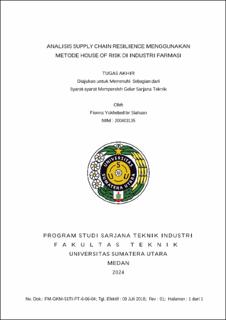Analisis Supply Chain Resilience Menggunakan Metode House of Risk di Industri Farmasi
Supply Chain Resilience Analysis Using House of Risk Methods in the Pharmaceutical Industry

Date
2024Author
Siahaan, Fionna Yokhebed Br
Advisor(s)
Tarigan, Indah Rizkya
Metadata
Show full item recordAbstract
Identification of risks is necessary for supply chain activity in a company so that the measurement of supply chain resilience is known. PT. Mutiara Mukti Farma (MUTIFA) is a company that operates in the pharmaceutical industry, making medicines. The problem of PT. Mutifa is that there is an obstacle to the distribution system of drug raw materials due to dependence on imports of medicine raw materials, which causes production disruption and the company's inability to meet the amount of customer demand when there is a disorder. The objective of this research is to measure supply chain resilience in Mutifa with resiliency zone maps through risk identification so as to provide preventive mitigation against risk to supply chain activity in Mutifa. The research methodology uses the House of Risk (HOR) method to identify each risk in the supply chain activity and provide mitigation proposals for priority risks. The results of this study show that there are 29 risk incidents and 25 operational risk causes in the supply chain activities of PT. MUTIFA. The House of Risks (Hor) Phase 1 shows 11 priority risk sources that cumulatively contribute 68% of the total value of the aggregate risk potential (ARP). The House of Risk Phase 2 produces 5 priority improvement proposals based on the level of effectiveness and ease of application, namely implementing forecast accuracy calculations, implementing quality control processes, making SOPs related to the scheduling/scheduling process, expanding the line of cooperation with alternative suppliers, and creating employee training programs. Resilience zone mapping shows seven major risk factors that can be addressed by making risk mitigation proposals that can improve the resilience of companies in the face of a disruption
Collections
- Undergraduate Theses [1479]
